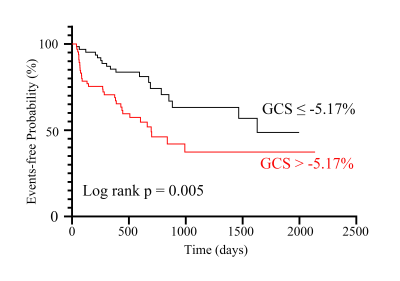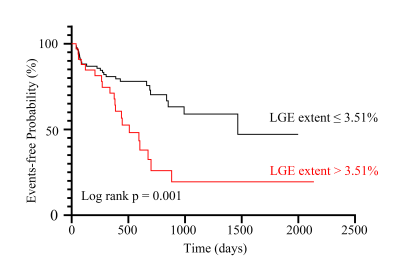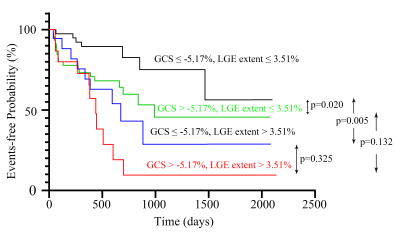0966
Prognostic Value of Global Circumferential Strain in Patients with Severe Dilated Cardiomyopathy1Department of Radiology, Union Hospital, Tongji Medical College, Huazhong University of Science and Technology, Wuhan, China, 2MR Collaboration, Siemens Healthineers Ltd., Shanghai, China
Synopsis
The prognostic value of strain parameters from cardiac magnetic resonance (CMR) cine images has been rarely studied in patients with severe dilated cardiomyopathy (DCM). In this study, we retrospectively identified 129 patients with severe DCM who underwent CMR. Strain and conventional CMR parameters were acquired from baseline CMR. The prognostic value of CMR parameters and clinical data for predicting adverse events was analyzed using Cox regression analyses. Global circumferential strain (GCS) was independently associated with adverse events after adjusting for clinical and imaging risk factors. GCS from CMR feature-tracking could be useful for risk stratification in patients with severe DCM.
Introduction
Myocardial fiber deformation measurements with global circumferential strain (GCS) using echocardiography speckle tracking or cardiac magnetic resonance (CMR) feature-tracking have been associated with adverse outcomes in patients with acute heart failure and myocardial infarction[1, 2]. However, few studies have addressed the prognostic value of GCS in patients with dilated cardiomyopathy (DCM) with severely impaired systolic function. This study aimed to evaluate the prognostic value of CMR-derived GCS in such patients.Methods
Consecutive patients with DCM with severely reduced ejection fraction (EF < 35%) who underwent CMR were retrospectively collected. Feature-tracking GCS was calculated from three long-axis and consecutive short-axis cine view. The clinical endpoint was a composite of all-cause mortality, heart transplantation, implantable cardioverter defibrillator (ICD) implantation, and aborted sudden cardiac death (SCD). Cox proportional hazards regression modeling was used to evaluate the association between GCS and adverse outcomes.Results
A total of 129 patients with a mean EF of 15.33% (range 11.36%-22.27%) were included. During a median follow-up of 518 days, endpoint events occurred in 50 patients, including 13 all-cause deaths, 20 heart transplantations, seven ICD implantations and 20 aborted sudden deaths. Using a Kaplan-Meier analysis, patients with GCS ≥ the median (-5.17%) had significantly reduced event-free survival compared with those with GCS < the median (log-rank test, p < 0.01).The Cox multivariable regression analysis revealed that GCS was independently associated with adverse events (p < 0.05) after adjusting for clinical and imaging risk factors including the extent of late gadolinium enhancement (LGE). Adding GCS into the model including the extent of LGE resulted in significant improvements in the C- statistic (from 0.706 to 0.742; p < 0.05) with a continuous net reclassification improvement of 29.71% (95% confidence interval: -0.015 to 0.692).Discussion
The left ventricular (LV) systolic function is a complex coordinated process involving longitudinal contraction, circumferential shortening, and radial thickening. LV myocardial contraction and relaxation were first impaired in the longitudinal direction, and LV function might be compensated by circumferential shortening to maintain EF[3]. The absolute longitudinal value in patients with DCM with severely reduced EF (< 35%) was much lower than that in patients with general DCM population described in a previous study[4]. Additionally, no longitudinal strain difference was found between patients with or without adverse events in our study. However, GCS was valuable in distinguishing high-risk entities among the subgroup of patients with DCM with severely reduced EF. More importantly, GCS showed significant associations with adverse events independently of the presence or extent of LGE after adjusting for clinical variables in the multivariable Cox regression models.Conclusions
GCS from CMR feature-tracking could be useful for risk stratification in patients with DCM with severely reduced EF, incremental to common imaging risk factors including LGE.Acknowledgements
None.References
[1] Cho G Y, Marwick T H, Kim H S, et al. Global 2-dimensional strain as a new prognosticator in patients with heart failure [J]. Journal of the American College of Cardiology, 2009, 54(7): 618-24.
[2] Hung C L, Verma A, Uno H, et al. Longitudinal and circumferential strain rate, left ventricular remodeling, and prognosis after myocardial infarction [J]. Journal of the American College of Cardiology, 2010, 56(22): 1812-22.
[3] Wang J, Khoury D S, Yue Y, et al. Preserved left ventricular twist and circumferential deformation, but depressed longitudinal and radial deformation in patients with diastolic heart failure [J]. European heart journal, 2008, 29(10): 1283-9.
[4] Romano S, Judd R M, Kim R J, et al. Feature-Tracking Global Longitudinal Strain Predicts Death in a Multicenter Population of Patients With Ischemic and Nonischemic Dilated Cardiomyopathy Incremental to Ejection Fraction and Late Gadolinium Enhancement [J]. JACC Cardiovascular imaging, 2018, 11(10): 1419-29.
Figures



